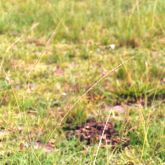Giant Parramatta grass

Giant Parramatta grass
© Queensland Government

Giant Parramatta grass infestation
© Queensland Government

Giant Parramatta grass habit
© Harry Rose Creative Commons

Giant Parramatta grass roadside
© Harry Rose Creative Commons

Giant Parramatta grass seedhead
© Harry Rose Creative Commons
Native to tropical Asia and Malesia, giant Parramatta grass is a clumping grass that looks very similar to another weedy sporobolus grass, giant rat's tail grass. It reduces pasture productivity and causes significant degradation of natural areas.
You must manage the impacts of Giant Parramatta grass on your land.
You must not give away, sell or release Giant Parramatta grass into the environment.
Scientific name
Similar species
- American rat's tail grass
- Giant rat's tail grass
- Sporobolus grass
Description
- Clumping grass 0.8–1.6m tall.
- Seed head is up to 50cm long and 1–2cm wide.
- Branches of seed head are pressed to axis and overlapping when young, opening out as they mature.
Habitat
- Adapts to a wide range of soils and conditions.
- Suited to conditions present in 60% of Queensland, including areas with low rainfall.
Distribution
- Visit Weeds Australia and click on the distribution tab to access the distribution map.
Life cycle
- Seeds set throughout frost-free period of the year.
- Produces up to 85,000 seeds per square metre each year with initial seed viability of about 90%.
- Seeds can remain viable for up to 10 years.
Impacts
Economic
- Invades pastures and replaces more productive types of grass, especially after overgrazing or soil disturbance.
- Causes loss in carrying capacity and decreased production by up to 80%.
- Mature leaf blades are tough and difficult for cattle to graze.
- Loosens teeth of grazing cattle and horses.
How it is spread
- Spread by livestock, invasive and native animals, vehicles, machinery and fast-flowing water.
Prevention
Control
Physical control
- Maintain dense vigorous pastures.
- Take great care to prevent dispersal by vehicles, implements and hay.
Herbicide control
- The giant rat's tail and other weedy Sporobolus species fact sheet (PDF, 7.8MB) provides herbicide control and application rates.
Biological control
- Biological control agents are under research for all weedy sporobolus grass species.
Legal requirements
- Giant Parramatta grass is a category 3 restricted invasive plant under the Biosecurity Act 2014.
- It must not be given away, sold, or released into the environment. Penalties may apply.
- You must take all reasonable and practical measures to minimise the biosecurity risks associated with dealing with Giant Parramatta grass under your control. This is called a general biosecurity obligation (GBO).
- At a local level, each local government agency must have a biosecurity plan that covers invasive plants in its area. This plan may include actions to be taken on Giant Parramatta grass. Some of these actions may be required under local laws. Contact your local council for more information.